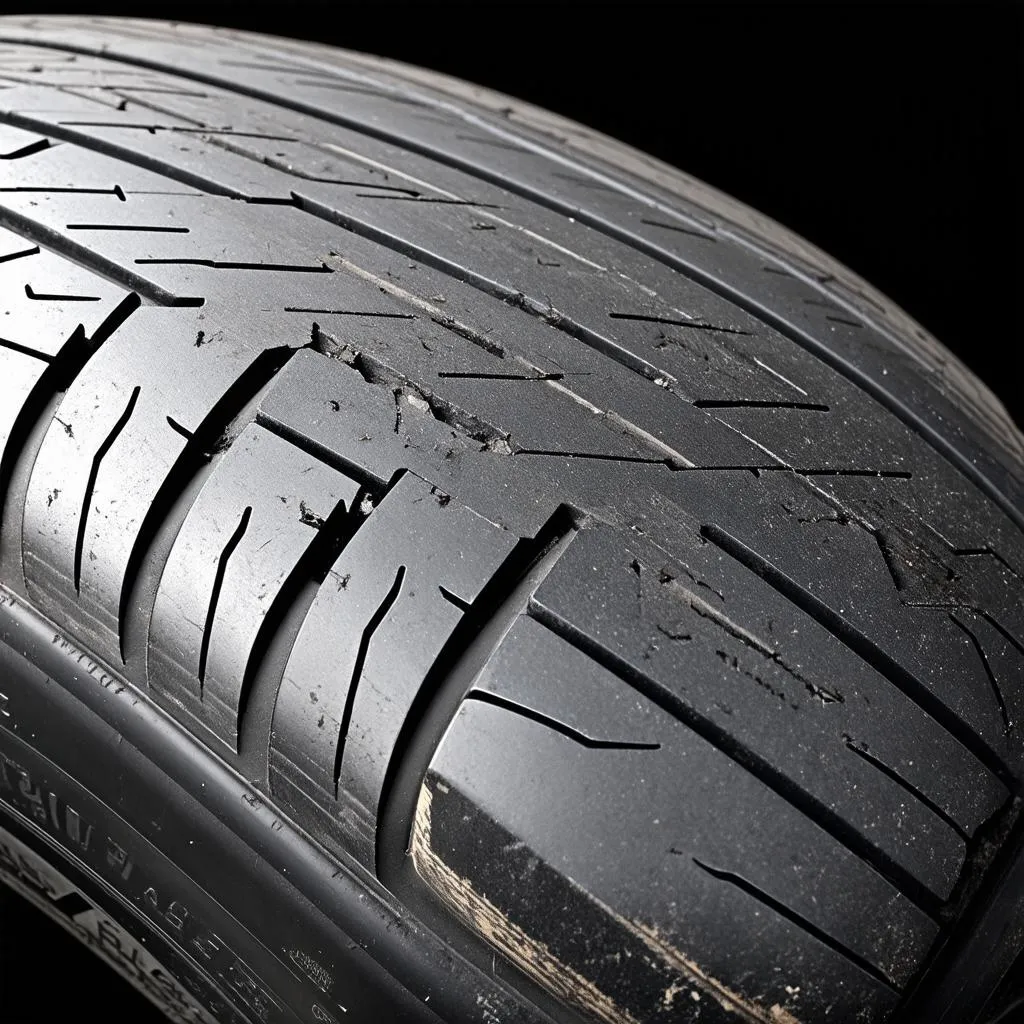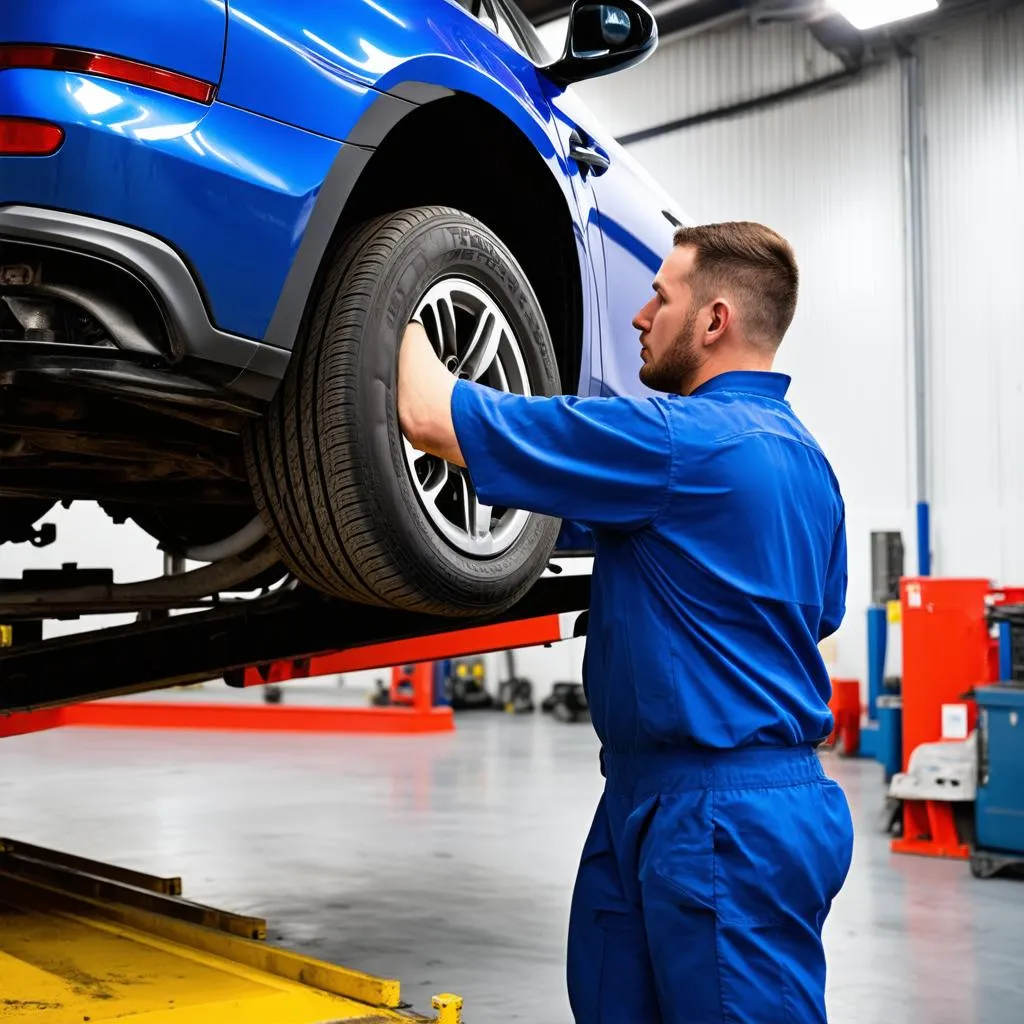Have you ever felt like you were driving a boat instead of a car? That unsettling, wobbly sensation can be unnerving, to say the least. Just ask John from Seattle, who described his Toyota Camry’s recent behavior as “driving on jelly.” He was rightfully concerned, and so should you be if your car feels wobbly. While there are many potential causes, some are more serious than others. This comprehensive guide will explore the common reasons for that shaky feeling, help you diagnose the problem, and offer solutions to get you back on the road to a smooth ride.
Decoding the Wobble: What Does It Mean?
Understanding why your car feels wobbly starts with identifying what kind of wobble you’re experiencing. Is it a gentle swaying, a violent shaking, or something in between? Does it happen at low speeds, high speeds, or all the time?
From a mechanic’s perspective, “wobbly” isn’t a technical term. It’s a symptom, and like any good mechanic, we need to identify the root cause. This requires asking the right questions and performing a thorough inspection.
From an engineering standpoint, a wobble often indicates an imbalance or misalignment in a vehicle’s system, be it the tires, wheels, suspension, or even the steering components. Each of these systems plays a critical role in keeping your car stable and planted on the road.
And let’s not forget the economic angle. Ignoring a wobbly car can lead to more severe and expensive problems down the line.
Finding the Culprit: Common Reasons Your Car Feels Wobbly
1. Tire Troubles: The Usual Suspects
In most cases, a wobbly feeling originates from the tires.
- Uneven tire wear: Just like your favorite pair of shoes, tires wear down over time. However, uneven wear, often caused by misalignment or worn suspension components, can lead to an uneven contact patch with the road, resulting in a wobbly sensation.
- Low tire pressure: Underinflated tires can cause a car to feel sluggish and unstable, particularly at higher speeds. This is because the tire’s sidewall flexes more, reducing contact with the road surface.
- Tire damage: A bulge in the sidewall, a bubble on the tread, or even a nail embedded in the tire can all throw off your car’s balance and lead to wobbling.
2. Suspension System: Keeping Your Ride Smooth
Your car’s suspension system, a complex network of springs, shocks, and linkages, is responsible for absorbing bumps and dips in the road, ensuring a comfortable ride and optimal tire contact. When components within this system wear out or become damaged, it can lead to that dreaded wobbly feeling.
- Worn shocks or struts: Shocks and struts dampen the up and down movement of your car’s suspension. When they wear out, your car may bounce excessively, especially over bumps, contributing to a wobbly sensation.
- Damaged control arms or bushings: Control arms connect your car’s wheels to the frame, while bushings provide a cushioned connection between suspension components. Worn or damaged parts in this system can cause instability and a wobbly feeling, particularly when turning or driving over uneven surfaces.
3. Alignment Issues: Steering You Straight
Proper wheel alignment is crucial for even tire wear and predictable handling. When your wheels are misaligned, even slightly, your car may pull to one side, wander on the road, or feel wobbly.
- Improper toe, camber, or caster: These are the three main angles that determine your wheel alignment. When any of these angles are off, it can lead to uneven tire wear and affect your car’s handling, potentially causing a wobbly feeling.
4. Steering System: Taking Control
The steering system is your direct link to the wheels, translating your input into turning motion. Any play or looseness in this system can compromise your car’s stability and lead to a wobbly feeling.
- Worn tie rod ends: Tie rod ends connect the steering rack to the steering knuckles, which turn the wheels. When they wear out, you may experience excessive play in the steering wheel and a wobbly sensation, especially at higher speeds.
- Steering rack issues: The steering rack is a critical component that converts your steering wheel input into the lateral motion needed to steer your car. A worn or damaged steering rack can lead to a variety of issues, including a loose steering wheel and a wobbly feeling.
5. Other Potential Culprits
While the above reasons are the most common, other factors can contribute to a wobbly feeling:
- Wheel bearing problems: A worn wheel bearing can cause a rumbling or grinding noise, vibration, and a wobbly sensation, especially noticeable at certain speeds.
- Brake issues: A sticking brake caliper or warped brake rotor can cause a pulsating sensation in the brake pedal and may also lead to a wobbly feeling, especially when braking.
Don’t Ignore the Wobble: Taking Action
Ignoring a wobbly car is akin to ignoring a toothache – it might seem like a minor annoyance at first, but it can quickly escalate into a much bigger problem. Driving with a wobbly car is not only uncomfortable but also potentially dangerous. Reduced stability and compromised handling can increase your risk of an accident.
If you experience any of these symptoms, it’s important to take your car to a trusted mechanic or dealership as soon as possible for a thorough inspection.
Smooth Ride Ahead: Tips for Prevention
Preventing a wobbly car is always better than dealing with the consequences:
- Regular tire maintenance: Check your tire pressure regularly, rotate your tires every 5,000-8,000 miles, and have your alignment checked at least once a year.
- Timely suspension inspections: Pay attention to any unusual noises or changes in your car’s handling and have your suspension system inspected by a qualified mechanic at regular intervals.
- Be mindful of road conditions: Avoid potholes and other road hazards whenever possible, as they can damage your tires, wheels, and suspension components.
 Worn Tire Tread
Worn Tire Tread
FAQs: Addressing Your Wobbly Car Concerns
Q: Can driving with a wobbly car damage it further?
A: Yes, absolutely. Continuing to drive with a wobbly car can exacerbate the underlying issue and potentially lead to more serious and expensive damage.
Q: My car only wobbles at high speeds. Should I be worried?
A: While some wobbling at high speeds can be normal due to road imperfections and wind resistance, a persistent or pronounced wobble should always be investigated by a mechanic.
Q: How much does it cost to fix a wobbly car?
A: The cost of repair depends entirely on the underlying cause. A simple tire rotation or balance may only cost a few dollars, while a complex suspension repair could run into the thousands.
Q: Can I fix a wobbly car myself?
A: While some car maintenance tasks can be performed at home, diagnosing and repairing a wobbly car often requires specialized tools and expertise. It’s best to leave it to the professionals to ensure the problem is properly addressed.
 Car Mechanic Inspection
Car Mechanic Inspection
Need Help with Your Wobbly Car? We Can Help!
At Diag XCar, we understand the frustration and concern a wobbly car can cause. Our team of expert mechanics is equipped with the latest diagnostic tools and knowledge to pinpoint the root of the problem and provide effective solutions. Don’t let a shaky ride ruin your day.
Contact us today at Whatsapp: +84767531508 for immediate assistance. Our friendly and knowledgeable team is available 24/7 to answer your questions, schedule an appointment, and get you back on the road to a smooth and safe driving experience.
Keep Exploring: Related Articles
- [Understanding Your Car’s Suspension System]
- [The Importance of Regular Tire Maintenance]
- [Common Car Problems and How to Solve Them]
We encourage you to share your thoughts and experiences in the comments section below. Have you ever dealt with a wobbly car? What was the cause, and how did you resolve it? Your insights may help fellow car owners facing similar issues.